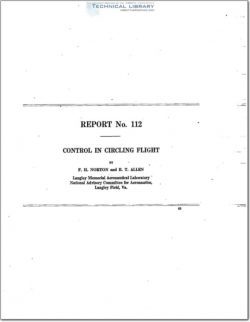naca-report-112

- Version
- 117 Downloads
- 1.34 MB File Size
- 1 File Count
- August 18, 2016 Create Date
- August 18, 2016 Last Updated
National Advisory Committee for Aeronautics, Report - Control in Circling Flight

This investigation was undertaken by the National Advisory Committee for Aeronautics
at the Langley Memorial Aeronautical Laboratory for the purpose of developing instruments
that would record the forces and positions of all three controls, and to obtain data on the be-
havior of an airplane in turns. All the work was done on a standard rigged JN4H (machine
No. 2 of N. A. C. A., Report N o. 70). It was found that the machine was longitudinally unstable
and nose heavy; that it was laterally unstable, probably due to too little dihedral; and that it
was directionally unstable, due to insufficient fin area, this last being very serious, for in case of
loss of rudder control the machine immediately whips into a spin from which there is no way of
getting it out. On the other hand, it was found possible to fly quite satisfactorily with the
rudder locked. and safely, though not so well, with the ailerons locked. The value of_ Y was
obtained 1n free flight, and when the effect of the propeller was subtracted, the agreement with
the model test was excellent, but with the propeller revolving at 1350 the value of Y was nearly
doubled. The value of L,T and N. were little affected by the slipstream, but their values do not
agree with the model test.
It has been attempted to present this report from'the standpoint of the engineer and pilot
as well as from that of the physicist, for the more time that is spent on practical stability, the less
important seems the theory of small oscillations as compared with the other phases of the prob-
lem. When one of the most used and well liked training planes is normally unbalanced and
statically unstable with free controls in every particular, it would seem that the dynamical
stability is at present of secondary importance. There are, of course, airplanes that are much
more stable than the machine used in these tests, but the point that should be emphasized is
that, generally speaking, a pilot does not know a. stable from an unstable machine, and if the
forces on the controls are small he is just as well satisfied with the unstable one as with the other.
It seems to be the general impression among nonflyers that piloting an unstable plane is analogous
to walking a tight rope, requiring constant vigilance and great dexterity, but the beginner
learns to fly as quickly in an unstable machine as in a stable one. It is not intended to give the
impression that stability is of no value, for this is certainly not the case; for a machine stable
with free controls could be brought down safely if a control wire broke and it would be less
tiring to the pilot m long flights.
| File | Action |
|---|---|
| naca-report-112 Control in Circling Flight.pdf | Download |
Comment On This Post